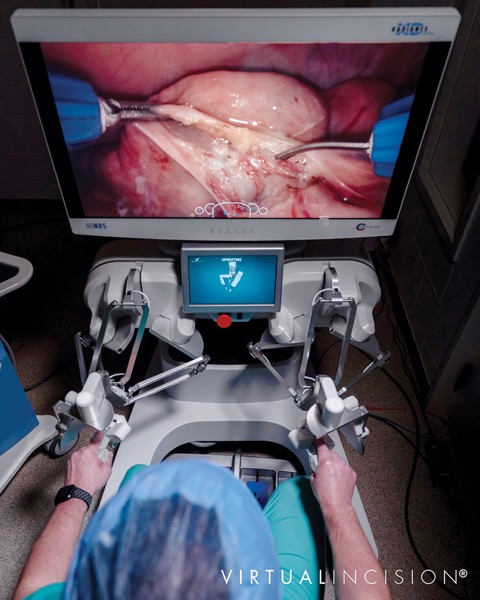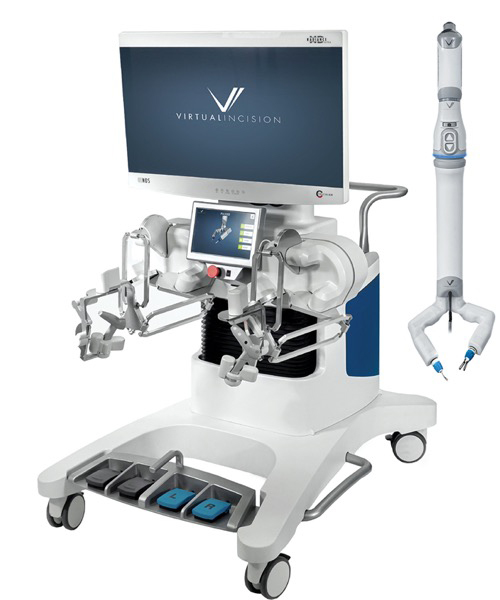We’ve glimpsed a possible future of robotic surgery, and it’s just slightly larger than a bread box.
Weighing less than 2 pounds, the miniaturized in vivo robotic assistant (MIRA) is about the size of a human hand and fits into a patient’s abdomen through a single 2.5- to 3-cm umbilical incision. Assembled together, the robot and a camera extend no more than 24 inches.
“When we started our research into robotic surgery, we thought the current iteration on the market—the very large and expensive da Vinci system [Intuitive Surgical]—was probably not the right way to go about it,” said Dmitry Oleynikov, MD, the co-founder and chief medical officer of Virtual Incision, a medical device company that develops miniaturized robotic support systems. “The analogy we use is comparing the big mainframe computers from the 1970s and 1980s to what we have now, in our watches and iPhones.”
The MIRA features a robotically controlled articulating scope that fits through the center channel of the robot, and two interchangeable instruments; it is designed to create triangulation between the camera and instruments to provide unobstructed visibility and reduce the risk for collisions during surgery. Once the device is placed through the gel port, the surgeon can manipulate it to look at all four quadrants.
“If the device needs to be advanced or withdrawn, that can be done with the help of the bedside assistant,” said Dr. Oleynikov, also the chair of surgery at Monmouth Medical Center and a clinical professor of surgery at Robert Wood Johnson Medical School of Rutgers University, in New Brunswick, N.J.
The device is still in an investigational stage and not available for sale in the United States, but Dr. Oleynikov anticipates the MIRA will be used for general surgery procedures including colon resection, cholecystectomy, sleeve gastrectomy and hernia repair, pending FDA approval.
In Paraguay two years ago, under strict research protocol, Dr. Oleynikov and his colleagues performed two colon resections with a slightly earlier prototype. “Both patients were successfully discharged from the hospital in just a couple of days with no problems or issues,” he said.
The MIRA’s small size does not require a dedicated space or infrastructure, nor does it need a dedicated setup team, which could give it an advantage over currently available robotic platforms. The system is designed to be used anywhere general surgery is performed—an academic medical center, a community hospital or an ambulatory surgery center.
“We anticipate the MIRA will open up access to robotic surgery much more broadly. Virtual Incision is focused on the underserved 80%-plus of the market that needs a smaller and simpler solution,” Dr. Oleynikov said.
Feedback from robotic and laparoscopic surgeons regarding ease of use has been promising, he said. “The learning curve for laparoscopic colectomy is around 55 cases. Robotics has reduced that learning curve to 15 to 25 for a colectomy. We expect the MIRA to further reduce the learning curve to five to 10 cases.”
The current system has two effectors, a bipolar grasper, monopolar scissors and a surgeon-controlled camera. The robot itself can be reused up to 15 times following sterilization, and the camera can be used up to 50 times. “Our plan would be to recycle the system after it has completed all of its cycles,” Dr. Oleynikov said.
Although the company has not yet put a price on the system—it is too early in development to determine—the cost of a procedure conducted with the MIRA is expected to be roughly equivalent to a laparoscopic operation.
Virtual Incision is working with the FDA for approval of its initial investigational device exemption trial, on which Michael A. Jobst, MD, will be one of the primary investigators. He has been consulting with Virtual Incision on the MIRA for a few years and has used it in a dry lab, pig models and a cadaver.
“I think it’s awesome,” said Dr. Jobst, a colon and rectal surgeon at Surgical Associates, PC, in Lincoln, Neb. “Other surgeons point out that it doesn’t have a vessel sealer or stapling capability, but in 2010, the da Vinci system didn’t have those features, either. At this stage in the game, the MIRA is a fantastic concept, and it’s taking surgical robotics in a different direction. I think it will, ultimately, be better.”


